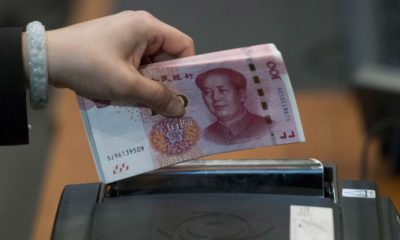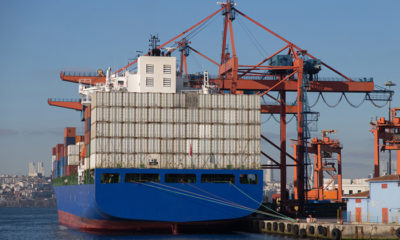Global markets shuddered as turmoil emanating from China spread around the world and billionaire George Soros warned of a crisis.
Chinese shares fell 7 percent within a half hour of opening, triggering a full-day trading halt, after the central bank cut the yuan’s reference rate by the most since August. Other equity markets tumbled, with European shares falling the most since September and U.S. futures indicating a lower open. Commodities weren’t spared as crude headed for its lowest settlement in 12 years. Haven assets gained, with Treasuries rising for a sixth day, the yen reaching a four-month high and gold surging.
“China has a major adjustment problem,” Soros said Thursday at an economic forum in Colombo, Sri Lanka. “I would say it amounts to a crisis. When I look at the financial markets there is a serious challenge which reminds me of the crisis we had in 2008.”
Contagion from China helped wipe $2.5 trillion off the value of global equities in the first six days of this year as the nation’s tolerance for a weaker currency is viewed as evidence that policy makers are struggling to revive an economy that’s the world’s biggest user of energy, metals and grains. The World Bank cut its global growth forecasts for this year and next as China’s slowdown prolongs a commodity slump and contractions endure in Brazil and Russia. Chancellor of the Exchequer George Osborne plans to highlight a “dangerous cocktail” of global threats faces the British economy this year.
China
The Hang Seng China Enterprises gauge of mainland shares listed in Hong Kong tumbled 4.2 percent, its lowest close since October 2011. The Hang Seng Index dropped 3.1 percent.
The Shanghai Composite Index tumbled 7.3 percent before trading was suspended. New circuit breakers, which kicked in on Monday, have been criticized by analysts for exacerbating declines as investors scramble to exit positions before getting locked in by the halts.
After the stoppage, the securities regulator announced rules to limit selling by major shareholders when a ban expires this week. The watchdog also held an unscheduled meeting on the tumbling stock market without coming to a decision on policy action, according to a person familiar with the discussions.
“The Chinese yuan is smack bang at the heart of concerns,” Chris Weston, chief market strategist in Melbourne at IG Ltd. “For risk assets to stabilize and sentiment to turn around, we are going to need a stable or even positive move in the Chinese currency. It’s clear that the market is becoming increasingly concerned by the global inflation outlook.”
The offshore yuan swung from a 0.3 percent gain to a 0.7 percent loss and back in the space of about 30 minutes in early activity in Hong Kong’s freely-traded market. It was subsequently 0.4 percent higher versus the greenback, while the onshore rate weakened 0.6 percent.
“We saw aggressive intervention in the offshore yuan market,” said Zhou Hao, an economist at Commerzbank AG in Singapore. “We don’t really understand the rationale behind the market movements in the past few days. Obviously, these movements have reminded us of the market rout last year.”
The central bank is considering new measures to prevent high exchange-rate volatility in the short term, according to people familiar with the matter.
China’s foreign-exchange reserves slid more in December than forecast, capping their first-ever annual decline, as authorities sought to prop up a weakening yuan.
Stocks
The Stoxx Europe 600 Index slid 3.2 percent at 1:07 p.m. in London, as all but 10 stocks fell. Commodity producers and carmakers, among those with the most sales exposure to China, led declines.
Anglo American Plc tumbled 9.6 percent and ArcelorMittal slid 6.1 percent, dragging a gauge of miners to its lowest level since 2009. A measure of energy producers also fell to a near six-year low, with Royal Dutch Shell Plc dropping 6.2 percent, the most since August.
Daimler AG, BMW AG and Volkswagen AG each lost at least 4.5 percent, helping pull Germany’s benchmark DAX Index below 10,000 for the first time since October.
The VStoxx Index measuring volatility expectations in euro-area shares jumped 17 percent, heading for its biggest weekly advance since April.
Futures on the Standard & Poor’s 500 Index lost 2.2 percent, after the U.S. benchmark slipped Wednesday to its lowest level in three months.
The MSCI Asia Pacific Index retreated 2.1 percent. Benchmark stock indexes in Australia, Japan, Singapore and Thailand all lost more than 2 percent.
Currencies
The yen, which has been the best-performing major currency so far this year amid the demand for safe-haven assets, rose as much as 1 percent to its strongest level since August versus the dollar.
The pound fell to the weakest level since June 2010, touching $1.4555. The U.K. currency slid 1 percent to 74.46 pence per euro. It has fallen every day this week against the dollar. Disappointing manufacturing and services data added to the view that the Bank of England will have to keep its benchmark interest rate lower for longer.
The Aussie tumbled 0.8 percent to 70.13 U.S. cents, and touched 70.09, its lowest since Oct. 2. It fell more than 3 percent through Wednesday, its worst start to any year since currency controls were scrapped in December 1983, according to data compiled by Bloomberg.
Commodities
The Bloomberg Commodity Index dropped 0.7 percent, headed for its lowest close since 1999.
West Texas Intermediate crude slid 3.3 percent to $32.86 a barrel, poised for the lowest settlement since February 2004. Crude supplies at Cushing, Oklahoma, the delivery point for U.S. crude, climbed to an all-time high, government data showed Wednesday. Brent oil will slump to $30 in the next 10 days, according Nomura Holdings Inc., while UBS Group AG sees an oversupply pushing prices even lower.
Copper retreated 2.6 percent in London to the lowest since Nov. 24 and zinc slumped 3.6 percent. Cocoa for March delivery fell for a fifth day to an eight-month low on ICE Futures U.S. in New York. Gold rose as much as 0.8 percent to a two-month high of $1,102.85 an ounce.
Bonds
Yields on 10-year Treasury notes fell one basis points to 2.16 percent, after earlier touching the lowest since October. Japanese government bond futures advanced to a record high after 30-year notes were auctioned at a higher price than dealers forecast. South Korea’s 10-year yield fell to a record low as the weakening yuan dimmed the outlook for exports to China and North Korea’s fourth nuclear test, conducted on Wednesday, spurred demand for safer assets.
Germany’s 10-year break-even rate, a gauge of the market’s outlook for inflation, tumbled to the lowest level since February amid concerns that the rout in commodity markets would subdue price-growth.
The cost of insuring investment-grade corporate debt climbed to the highest since Oct. 6. The Markit iTraxx Europe Index of credit-default swaps on highly rated companies rose four basis points to 85 basis points. The Markit iTraxx Europe Crossover Index of default swaps on junk-rated companies jumped 16 basis points to 351 basis points, the highest since Dec. 15.
Emerging Markets
Energy producers led losses in developing-nation stocks, driving the MSCI Emerging Markets Index down 2.7 percent. Benchmark gauges in South Africa, Thailand, the Philippines and Abu Dhabi slid more than 2.5 percent and those for Saudi Arabia, Dubai and Qatar tumbled at least 3 percent. Russian markets were closed for a holiday.
A gauge tracking 20 emerging-market currencies dropped for a fifth day, headed for its longest losing streak since October. The rand in South Africa, which counts China as its biggest trading partner, tumbled 1.5 percent to a record low. Russia’s ruble slid 1.1 percent in offshore trading while Mexico’s peso and Brazil’s real slid at least 0.6 percent.
Bloomberg


 Billionaire Watch3 weeks ago
Billionaire Watch3 weeks ago
 Startups4 weeks ago
Startups4 weeks ago
 News4 weeks ago
News4 weeks ago
 News4 weeks ago
News4 weeks ago
 Bitcoin4 weeks ago
Bitcoin4 weeks ago
 Naira4 weeks ago
Naira4 weeks ago
 Forex3 weeks ago
Forex3 weeks ago
 Treasury Bills4 weeks ago
Treasury Bills4 weeks ago






















